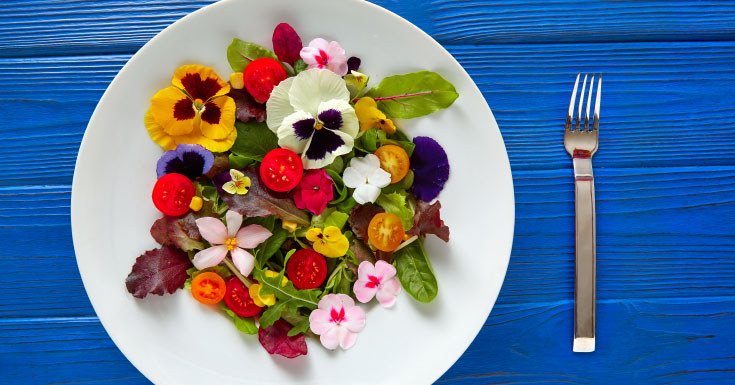Toss them into your salad; bake them into your biscuits or decorate your cupcake with them. You can even flavour your oils with them, or, use them in drinks or jams. We’re talking about edible flowers. Yes, flowers. Roses, lavender, hibiscus and the likes. Who would have thought that one day the culinary world would just go bonkers for these colorful, flavorful and nutritious ingredients? Are you ready to jump in with it?
Pretty to look at, flowers carry their own unique meaning and there are ‘suitable’ blooms to match every special occasion. But do you know what they are even more suitable for? Your consumption! Most edible flowers are nutrient-dense, with Vitamin C, Vitamin E, lutein, calcium and potassium being some of the main nutrients. Surely you’ve heard of (or perhaps even have tried) flower teas before? Delicious and refreshing, aren’t they not? But why just stop there? Go ahead and make them a part of your diet, starting right now.
Edible flowers: Here are Eight to Eat!
Rose
Roses don’t just smell heavenly, they are flavourful too! Toss them into your salad, or make a cup of tea with some dried roses the petals contain polyphenols, antioxidants that work to protect your body from cell damage. The polyphenols in roses can also help reduce the risk of heart disease, diabetes, obesity, and cognitive diseases.
Calendula
The calendula blossom is also considered a herb, and it has antifungal and antimicrobial properties that can help prevent infection and heal injuries to body tissues. Calendula is also known to have anti-inflammatory and antioxidant components, which might help to fight cancerous growths, protect against heart disease, and ease muscle fatigue. The peppery, tangy, and spicy blossom can be eaten cooked or raw, but it retains more of its nutritional value (and vibrant colour!) when consumed fresh.
Hibiscus
Our very own national flower contains antioxidants that help prevent cholesterol deposits and aids liver disorders. Include them in your diet to help boost your immune system and prevent cell damage caused by free radicals in the body. The antioxidants such as anthocyanins in hibiscus flowers can help reduce your risk of developing many significant health complications such as heart disease, diabetes, as well as some cancers.
Fuchsia
What a bright, colorful way to boost your Vitamin C intake! These lovely flowers are high in anthocyanins, the group of compounds that give them their distinctive fuchsia reddish, purplish, bluish colors. Anthocyanins are potent antioxidants which mop up free radicals in our body and keep our cells from aging too quickly. Chop some up for your dinner tonight, either on your salad, or even in your yogurt!
Pansy
While the blue pansy may be the most popular of them all, these flowers are available in many colours, all bright and antioxidant-rich for a healthy boost of nutrients! Rich in Vitamin C, tannins, carotenoids, and saponins (among other nutrients), pansies have long been lauded by herbalists for their anti-inflammatory properties. Get colorful and go for a pack of multi-coloured pansies for a powerful punch of nutrients, and not to mention, pretty up your dishes too.
Dandelion
An all-star in the world of edible blooms, the dandelion’s health benefits are plenty. These little yellow blooms are antioxidant-rich which makes them a welcome addition to any healthy meal plan. They also contain compounds that help control blood sugar levels, which is particularly important in diabetes management.
Carnations
Carnations contain substances that soothe the nervous system, reduce inflammation and swelling. They are useful in restoring women’s health too, particularly in hormone balancing. Carnations’s anti-inflammatory properties are useful in reducing muscle tension in uterine tissues and reducing the pain and irritation of menstrual cramps. The flower also boasts cleansing properties that break down toxins in the body and helps improve blood circulation.
Blue butterfly pea
These bright blue blossoms are known to improve skin and hair health thanks to its rich antioxidant content. Eat them raw to help slow down skin aging and improve overall skin tone and texture. Small yet potent, the blue butterfly pea also contains essential nutrients that nourish hair follicles and promote hair growth.
Before you start to include flowers into your diet, read this!
- Only eat flowers you know to be edible. Do your research if you are not sure about a certain bloom.
- Do not eat flowers bought from a florist, roadside flowers or those picked in public parks, for these may have been treated with pesticide or herbicide.
- If you suffer from allergies, introduce edible flowers into your diet one type at a time, and do it gradually
















